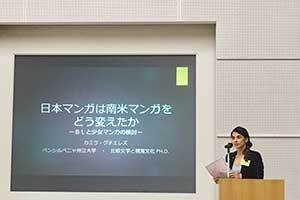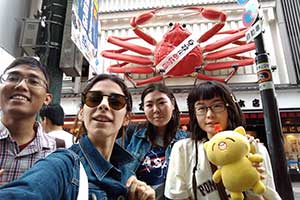

 2019 JAPAN FOUNDATION JAPANESE-LANGUAGE PROGRAM FOR SPECIALISTS IN A CULTURAL FIELD
2019 JAPAN FOUNDATION JAPANESE-LANGUAGE PROGRAM FOR SPECIALISTS IN A CULTURAL FIELDMy name is Camila Gutierrez, a Chilean citizen and a graduate student at The Pennsylvania State University in the United States. As I write this piece, I am starting my third year of study towards earning my Ph.D. in Comparative Literature and Visual Studies. The characteristics of my research project have made it necessary for me to improve my Japanese language skills, which I was able to do this past summer thanks to my participation in the Japan Foundation's Japanese-Langauge Program for Specialists in Cultural and Academic Fields.
After a few semesters of study completing regular coursework at Penn State, it became necessary for me to have an intensive and immersive experience in the language. I compared this program to others, and it became clear that the program offered by the Japan Foundation was the most adequate to my needs: the program includes intensive language lessons, immersive cultural experiences, and personalized attention to the researcher’s needs. In what follows, I will be describing these three aspects in more detail:
Language Study: Upon arrival to the Kansai Institute in the port area of Rinku Town, I was introduced to my fellow participants and asked to sit a placement test to gauge our skills and required study level. The placement test is described differently by each participant, but in my experience it was a bit overwhelming to confirm just how rusty I was after not taking Japanese coursework for a while. The instructors were very encouraging even after seeing my lower score. When asked which lessons I wanted to sign up for (there is a mandatory schedule and an elective roster), I decided to sign up for all the classes I could take. Initially it seemed like an ambitious feat, but after spending time with my colleagues and seeing that we all had individual goals, I felt quite comfortable being in class for so many hours a week. In fact, with time we realized we were all struggling with similar things, and we ended up helping each other quite a lot! I saw significant improvement within the first couple of weeks, which is mostly a testament of how excellent the lessons and the environment were.
Our teachers rotated daily for the main nihongo class, but were stable weekly for kanji, kaiwa (conversation), and hapyo (presentation) modules. Thus, our learning felt dynamic and social, while also maintaining an efficient structure. How Japanese! At the end of the program we repeated the placement test and celebrated our evident improvement. However, it was not just testing scores that can show it. Near the end of the program we were having conversations mostly in Japanese during lunch time, or communicating with local researchers more comfortably if not fluently. Finally, and most importantly, our capacity to do research in the language started to emerge and become part of our skills. More about this below.
 Cultural Experiences: Throughout the program we were welcome to participate in three cultural experiences facilitated by the Japan Foundation. These included shodo (calligraphy), sadoo (tea ceremony) and bunraku (puppet theatre). Of course, these are only the scheduled activities, but beyond that we also participated in local culture by going to the fish market every Sunday morning, or visiting Osaka in various capacities. Shodo and sadoo were taught by local professional schools in these traditional arts. The Kansai Institute has a washitsu (traditional Japanese room) where we enjoyed tea ceremony. Calligraphy was practiced in a regular classroom and our final products were on exhibit in the institute hall for a couple of weeks after. Puppet theatre included a visit to the spectacular national theatre in Osaka, where professional puppeteers allowed us to hold and touch real puppets. This might have been one of my favorite experiences visiting Japan so far.
Cultural Experiences: Throughout the program we were welcome to participate in three cultural experiences facilitated by the Japan Foundation. These included shodo (calligraphy), sadoo (tea ceremony) and bunraku (puppet theatre). Of course, these are only the scheduled activities, but beyond that we also participated in local culture by going to the fish market every Sunday morning, or visiting Osaka in various capacities. Shodo and sadoo were taught by local professional schools in these traditional arts. The Kansai Institute has a washitsu (traditional Japanese room) where we enjoyed tea ceremony. Calligraphy was practiced in a regular classroom and our final products were on exhibit in the institute hall for a couple of weeks after. Puppet theatre included a visit to the spectacular national theatre in Osaka, where professional puppeteers allowed us to hold and touch real puppets. This might have been one of my favorite experiences visiting Japan so far.
 Other interesting things in Osaka included our “Osaka Orienteering day”, and various personal research trips. On Orienteering day, the institute gave us an unlimited train-ride ticket and a list of tasks to complete. My team planned a visit to an art museum, a boat ride that took us to nipponbashi and other bridges in the heart of Osaka, and a breathtaking cruise ride in Osaka bay at sunset. In one day we became familiar with this megacity, and some of the amazing things it has to offer.
Other interesting things in Osaka included our “Osaka Orienteering day”, and various personal research trips. On Orienteering day, the institute gave us an unlimited train-ride ticket and a list of tasks to complete. My team planned a visit to an art museum, a boat ride that took us to nipponbashi and other bridges in the heart of Osaka, and a breathtaking cruise ride in Osaka bay at sunset. In one day we became familiar with this megacity, and some of the amazing things it has to offer.
Research: Besides language and culture, this specific program is research-oriented and it shows. Once a week I was able to meet with my assigned tutor, who sat with me and helped me read through complicated texts of my choosing. Others, for whom classical Japanese is an area of study, were able to sit with bungo-trained tutors as well. To researchers like us, this resource turned out to be invaluable. It is extremely rare to have personalized research-specific tutoring built into conventional Japanese language program.
Research was also supported by the Kansai Institute’s fantastic library and their kind librarians. Hatakenaka-san was the librarian I worked with personally. She was eager to learn about my research and helped me identify materials I needed. She even purchased materials I could use during my stay, and kept track of my progress through books to continue suggesting new ones. Again, a human factor of sincere dedication that makes this program stand out among others.
 For those who needed to do research outside of the Kansai area, there was a weekend where we could go to Tokyo and stay at the Japan Foundation Japanese-Language Institute, Urawa. The institute, again, provided a JR ticket with Shinkansen access for us to use at our convenience. I used that weekend to visit the National Diet Library for two days in a row, and to visit the Shojo Manga Museum in Akiruno province. At the NDL I was able to photocopy articles that I could not have accessed quite so easily otherwise. At the Shojo Manga Museum I browsed through dozens of magazines in an open-stack library of vintage materials, and took hundreds of photographs with authorization of the collector. Nowhere in the world is there such a complete and accessible collection of these materials. The support of the Japan Foundation in this trip was instrumental to my writing the first chapter of my dissertation, which is underway at the moment. Further, during weekends when we had nothing scheduled, we were free to travel the region for more research opportunities. I used that freedom of travel to visit and interview a professor at Kyoto Seika University. Others visited Osaka libraries, museums, collections, and even nature reservations in the greater Kansai region.
For those who needed to do research outside of the Kansai area, there was a weekend where we could go to Tokyo and stay at the Japan Foundation Japanese-Language Institute, Urawa. The institute, again, provided a JR ticket with Shinkansen access for us to use at our convenience. I used that weekend to visit the National Diet Library for two days in a row, and to visit the Shojo Manga Museum in Akiruno province. At the NDL I was able to photocopy articles that I could not have accessed quite so easily otherwise. At the Shojo Manga Museum I browsed through dozens of magazines in an open-stack library of vintage materials, and took hundreds of photographs with authorization of the collector. Nowhere in the world is there such a complete and accessible collection of these materials. The support of the Japan Foundation in this trip was instrumental to my writing the first chapter of my dissertation, which is underway at the moment. Further, during weekends when we had nothing scheduled, we were free to travel the region for more research opportunities. I used that freedom of travel to visit and interview a professor at Kyoto Seika University. Others visited Osaka libraries, museums, collections, and even nature reservations in the greater Kansai region.
At the end of the program, all 11 participants presented our research projects and findings in a day-long conference at the Kansai Institute. The conference was attended by local people, instructors, visiting researchers, and even fellowship advisors for some of us. I can say with great pride that I was able to explain my project –even if with simple words– to a crowd who engaged in a stimulating Q&A with me.
Most of the things I have detailed above are work-related and probably useful to those interested in the program. Next, I want to leave a few notes on life at the institute:
 To conclude, the Japan Foundation's Japanese-Language Program for Specialists in Cultural and Academic Fields is overall the best opportunity to improve your research-specific Japanese language. I graduated more confident in my abilities, more capable to find and use Japanese-language materials, and more aware of my strengths and weaknesses to continue to improve in the future. I am very grateful to the Japan Foundation for choosing me to be part of the 2019 summer program.
To conclude, the Japan Foundation's Japanese-Language Program for Specialists in Cultural and Academic Fields is overall the best opportunity to improve your research-specific Japanese language. I graduated more confident in my abilities, more capable to find and use Japanese-language materials, and more aware of my strengths and weaknesses to continue to improve in the future. I am very grateful to the Japan Foundation for choosing me to be part of the 2019 summer program.